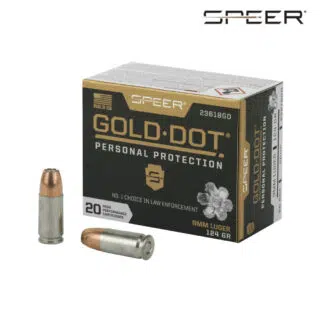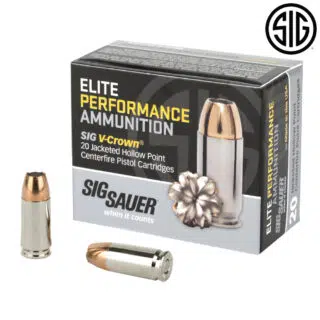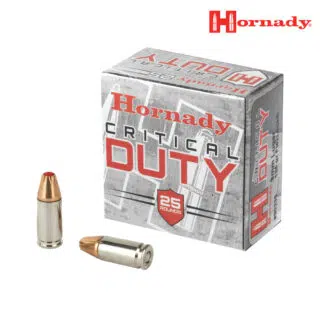The Best Defensive Ammunition For Your 9mm Pistol
After riots, pandemics, and electoral chaos, the message finally hit home. When it comes to the defense of self, family, and property, it’s all up to you. Logically, you started your Second Amendment journey by acquiring a modern striker-fired 9mm pistol. Whether it’s a GLOCK, SIG Sauer, Smith & Wesson, or Heckler & Koch pistol, you’ve taken that critical first step. In addition to the usual accessories like spare magazines from The Mag Shack, one major question that is likely to come up is in regard to ammunition selection. While selecting 9mm full-metal jacket training ammunition is a fairly straightforward process (i.e., is it reliable?), the process of selecting defensive ammunition for your 9mm pistol can be rather involved and confusing, especially for those who are uninitiated to the world of firearms.
When researching for the best defensive ammunition for your 9mm pistol, one will be presented with a bewildering array of parameters and options – from projectile materials, to bullet weights, to specifics such as whether the cavity in a hollow-point projectile is filled with a material to increase penetrative capabilities (Hornady’s polymer plug concept).
Along those lines, outside of certain exotic concepts like the Honey Badger projectile from Black Hills, where the projectile is shaped almost like an auger or drill bit to accomplish tissue displacement, the bulk of 9mm defensive ammunition sports a hollow-point projectile, usually made of lead with a copper jacketing, or straight-up solid copper.
Merely making a hollow point projectile and fitting it to a casing does not automatically make an effective 9mm defensive round though. Certain standards must be met.
9mm Defensive Ammunition Standards
Ammunition advertising is rife with claims of “stopping power”, velocity, and terminal effects. While it makes for snappy marketing and is sure to guarantee a quick sale from some impulse buyers, the more discerning ammunition purchaser will look beyond the ad copy and do a deep dive into real-world performance.
One benchmark for 9mm defensive ammunition is to research and observe what noted law enforcement agencies choose to equip their officers with. This is public information, but to be fair it will take some time to ferret out. Outside of contacting departments directly, the relevant nuggets of data will often be buried in procurement requests, year-to-year reports, and documentation about officer-involved shootings, since the forensics report will include the type of firearm the officer used, along with the details of the ammunition involved. To save you some time, chances are the round used will be from Federal, Speer, Winchester, or Hornady – the “Big Four” ammunition suppliers in the US.
While interesting and a worthwhile project all on its own, diving into reams of police reports and Excel spreadsheets is pretty time-consuming, and you run a fair chance of “going down the rabbit hole” and not accomplishing your original goal of finding the best 9mm defensive ammunition for your handgun.
With that in mind, the best way to select your 9mm hollow point ammunition is to find loads that meet and exceed the FBI Ammunition Test Protocol.
The FBI Ammunition Test Protocol Explained
In times of old, the Federal Bureau of Investigation set the practical standard for almost everything related to law enforcement in the United States. From investigative techniques to ammunition standards, if the FBI did it, everyone else did so as well.
The 1980s were a crazy time for American law enforcement. From the rise of street gangs in the cities to the Cocaine Cowboys of Miami, federal, state, and local law enforcement had their hands full. Things came to a head in 1986 during the infamous FBI shootout, where a small group of field agents for the FBI attempted to apprehend William Russell Matix and Michael Lee Platt, who were suspected of committing a series of violent crimes in and around the Miami metropolitan area.
After an intense battle where two FBI agents lost their lives in addition to the deaths of Matix and Platt, the agency began to investigate the “why” behind the failures in this incident. Partly to blame was the fact that most of the agents engaged in the battle were equipped with revolvers, and still more telling was that the ammunition issued to the agents lacked sufficient terminal effectiveness, especially at longer ranges.
The first major change was the FBI pivoted from issuing revolvers to their agents to issuing semi-automatic magazine-fed pistols. The first iteration was the Smith & Wesson 1076 10mm pistol. As the 10mm load proved too harsh for newer recruits, the FBI pivoted once again and chose the newly-developed .40 S&W cartridge for duty use. Years later, the agency would finally pivot to 9mm Luger GLOCK pistols, owing to advances in 9mm defensive ammunition technology.
The long-term effect of their research was the FBI Ammunition Test Protocol.
Regardless of caliber, in order for a round to be acceptable for the FBI, and by extension general law enforcement service, the round has to meet or exceed the standards outlined in the test.
So, what are the standards? It is a little more complex than one can imagine.
FBI ammo testing requires the use of a standard medium. 10% Ballistic Gelatin. This ballistic gel mix is a 10% ordnance gelatin formulation that is chilled to form blocks. The idea is to provide a simulation and average of a human target.
To test, the bullets are fired into a ballistic gel block from a distance of 10′ and data is collected about how each load performs. There are six different tests conducted by shooting ballistic gel. They are:
- bare gelatin, no barriers
- heavy clothing on gelatin, no barriers
- light clothing, steel barrier
- light clothing, wallboard barrier
- light clothing, plywood barrier
- light clothing, automobile glass barrier
Each of the barriers and clothing choices is made to simulate shooting circumstances that law enforcement agents may encounter. While as citizens we may not be dealing with shooting at threats through automobile glass, it is comforting to know our ammunition will perform accordingly if needed.
The standard is exacting in its detail, allowing for repeatability in FBI and independent laboratories to ensure ammunition performance.
In the FBI protocol, bullets that fail to penetrate 12″ or penetrate beyond 18″ are penalized. Bullets that expand and penetrate between 12″ and 18″ of gelatin are generally considered acceptable. Proper expansion is defined as the projectile expanding to 1.5 times its original diameter.
One thing worth noting is that the standard penalizes overpenetration. The reasoning is simple. When utilizing a defensive 9mm hollow-point round, one wants it to strike the threat, incapacitate the threat, and do nothing else. A round that over-penetrates can potentially strike an innocent bystander.
It’s a precise requirement, one that both professional and citizen users should look for in their defensive ammunition. To be fair, there’s a lot of ammunition on the market that does not meet the standard. While some may work half the time, is potential cost savings worth the risk to one’s life? Selecting a 9mm defensive load that meets the FBI Protocol is a sensible decision.
With that in mind, which 9mm defensive ammunition makes the grade?
The Best Choices For 9mm Defensive Ammunition
As the market for 9mm handguns has grown over the years, more and more ammunition suppliers are realizing that their customer base, both in the law enforcement and citizen sectors, are educated and savvy shoppers. The internet has a lot more data out there than just memes and Elon Musk trolling, after all.
A discerning ammunition purchaser can easily find “the numbers” on a potential 9mm defensive ammunition purchase. Confident ammunition manufacturers will make the results of testing readily available. To be blunt, if there’s no discernable data on a round, it’s advisable not to purchase it. The ammunition being purchased could potentially save your life in a defensive encounter – act accordingly.
With that in mind, here are some of the best choices for 9mm defensive ammunition currently on the market.
1. Speer 9mm Gold Dot Hollow Point 124 Grain
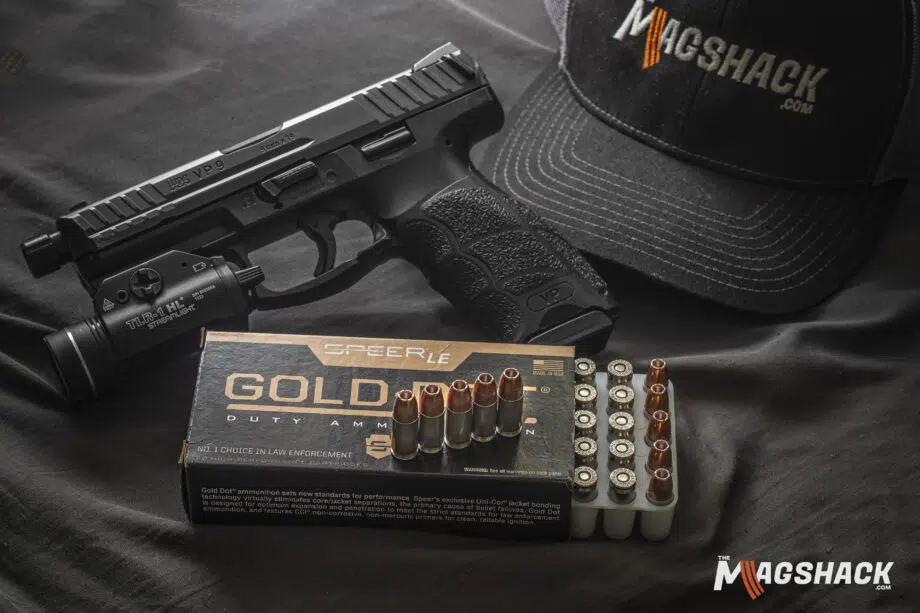
Speer 9mm Gold Dot Hollow Point 124 Grain +P Ammunition
With an average penetration of 14.1 inches in heavy clothing, the Speer Gold Dot Hollow Point 9mm 124 grain is a “gold standard” of 9mm defensive ammunition. Being the issued ammo to many a high-profile law enforcement agency over the past few decades, Speer’s 9mm Gold Dot Hollow Point loads have a proven track record on the streets to back up their solid numbers in the lab.
Though not the latest “whiz-bang” projectile, the GDHP family of 9mm cartridges is a solid go-to for citizen use. Featuring a copper jacket that’s bonded to the lead alloy core, each projectile is formed in a two-stage process to facilitate repeatable terminal effectiveness. The cartridge casings are nickel-plated for reliable feeding and corrosion resistance. Rounded out with low-flash powder and primers, this round is a prime choice for defensive applications.
2. SIG Sauer V-Crown 9mm 115 Grain Ammunition
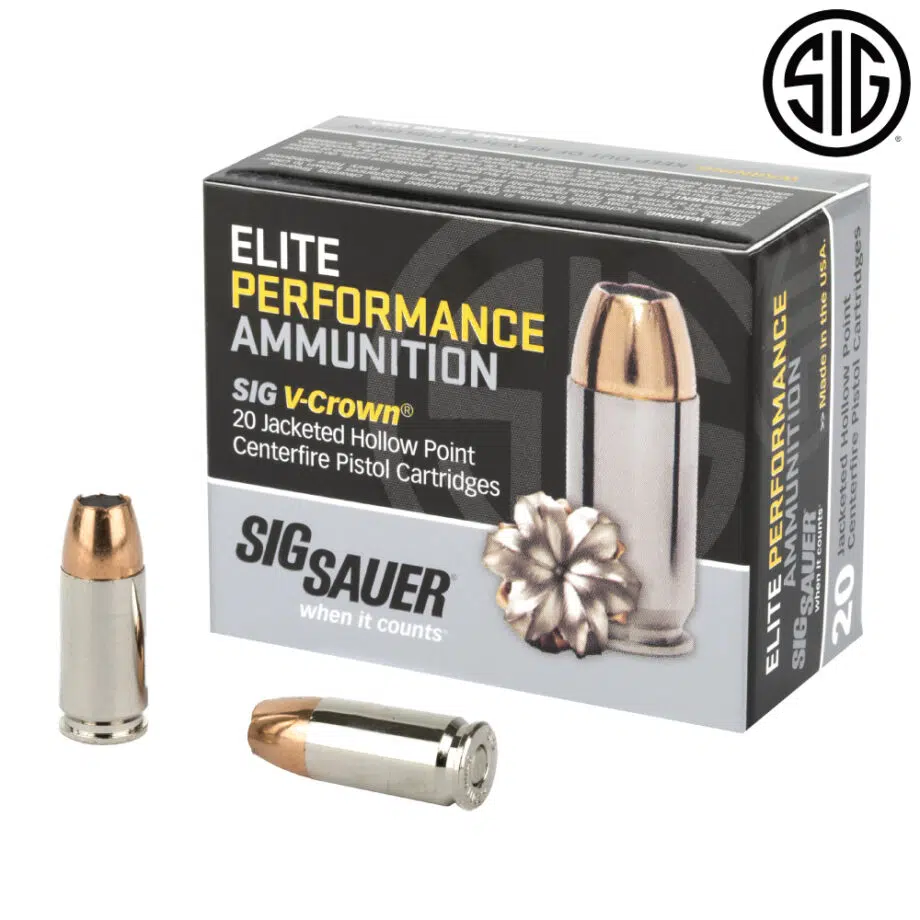
SIG Sauer V-Crown 9mm 115 Grain Ammunition
Fairly new to the ammunition game, SIG Sauer has recently opened a new production facility in Arkansas to produce their own line of ammunition. Sourcing their V-Crown projectile from the legendary Sierra Bullets, SIG has entered the 9mm defensive ammunition market with a purpose. Most notably, the V-Crown projectile consists of V-shaped skives (cuts) in the projectile to provide a controlled and uniform expansion on target.
In addition, an interesting feature is that there’s an additional small cavity in the “pit” of the hollow point, providing an additional cavity for enhanced terminal performance. A nickel-plated casing provides corrosion resistance – important for those of us in humid climates like here in the Gunshine State! – and more reliable feeding. Independent testing depicts that the SIG Sauer V-Crown 9mm 115 Grain hollow point cartridge meets the FBI Protocol standard with an average of 15 inches of penetration in ordnance gelatin.
3. Hornady Critical Duty 9mm Luger 135 Grain Flex Tip
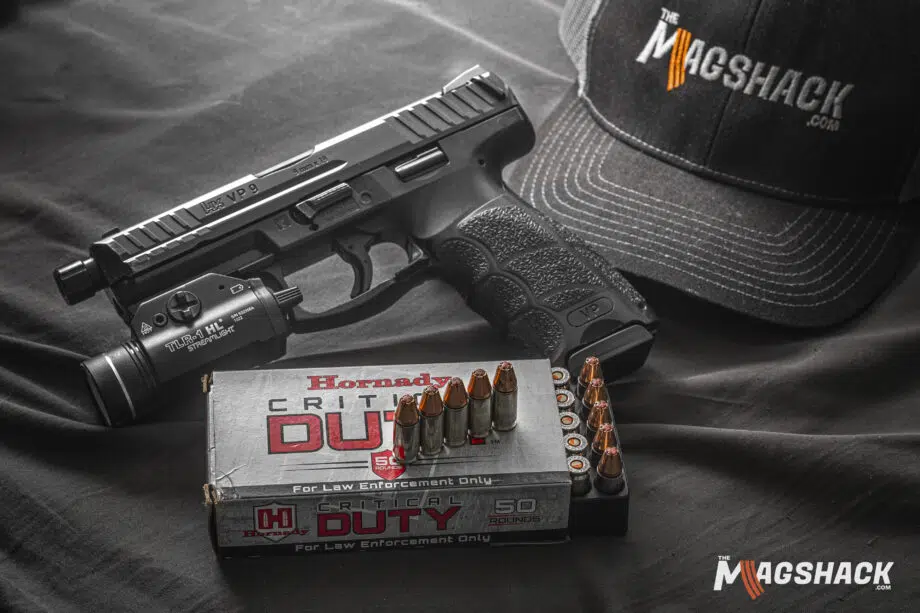
Hornady Critical Duty 9mm Luger 135 Grain
One of the most storied and patriotic ammunition manufacturers out there, Hornady, has a solid line of 9mm defensive ammunition for both professional and citizen use. Termed “Critical Duty” in their branding, this ammunition is sought out by professionals and citizens looking for a decisive edge in their defensive game. Among the best loads is the 9mm Luger 135 gr cartridge.
Produced in the unusual projectile weight of 135 grains, this cartridge specifically has become a sought-after choice for individual professionals where their departments allow some latitude in ammunition purchasing, as well as citizens who have sat down and done their research. Critical Duty ammo provides what Hornady calls “barrier blind” performance. This means that the round has similar expansion, penetration, and weight retention on typical barriers such as glass, metal, wood, and clothing. One who deploys this ammo can be confident in consistent performance regardless of the situation.
The bullets use the company’s FlexTip (the distinctive red “plug” in the projectile) technology, which is a polymer-filled hollow point. The Flex Tip prevents the hollow point from being filled when passing through clothing or another barrier, only expanding when organic tissue is encountered. Multiple independent lab tests have this ammunition exceeding FBI standards with 14 to 15 inches of penetration on gelatin covered by heavy clothing.
Oh, and as a bonus, Hornady themselves do nice things like refusing to sell to law enforcement agencies in certain states hostile to the Second Amendment. You know the ones.
Choosing The Right 9mm Defensive Ammunition Is A Lifesaving Decision
The stories and lore surrounding defensive shootings in both citizen and professional circles are rife with “oh no” moments.
“I shot him six times center mass and he still managed to keep going!”
“I thought he was out of the fight and he still put a round into my leg when I approached him!”
Getting involved in a defensive shooting situation is no joke. It’s truly a life-changing experience. As an instructor once said, “A little bit of yourself leaves the barrel of your gun if you have to shoot someone that day…”
In a defensive shooting, the goal is to win decisively by neutralizing the threat. Ensuring that happens either by rapid blood loss or a successful central nervous system hit is key. It is why characteristics such as expansion, penetration, and bullet weight retention are critical. 9mm defensive ammunition that delivers on these parameters and specifications should be sought out and acquired in sufficient quantities for multiple defensive encounters.
Today’s world has many uncertainties – don’t let your defensive ammunition selection be one of them.
